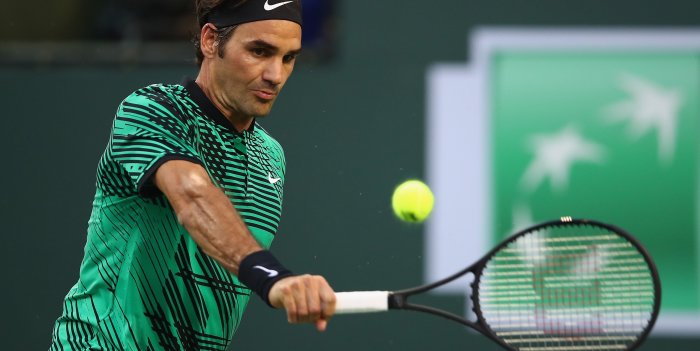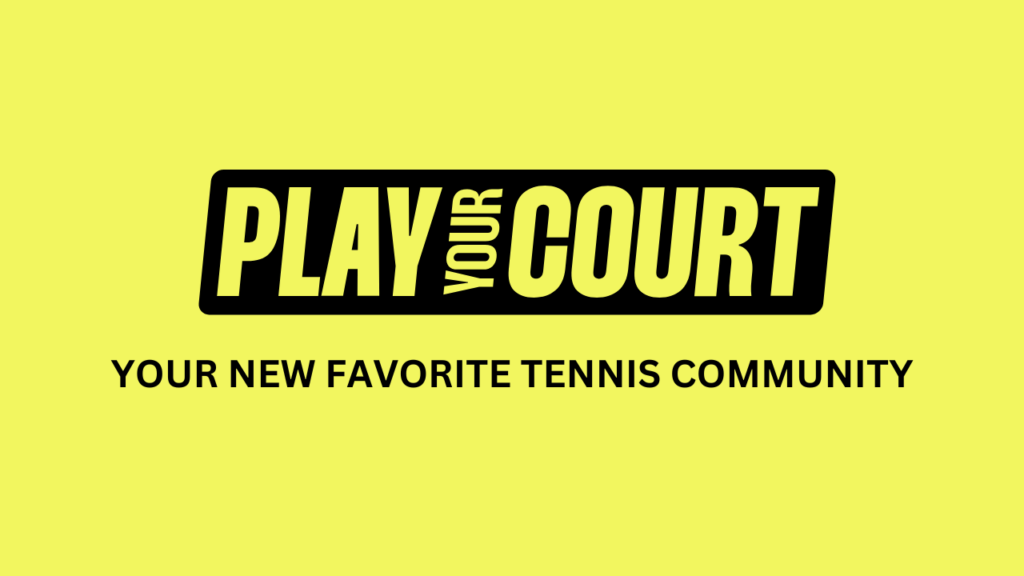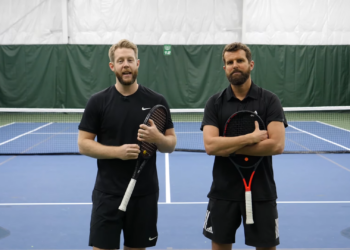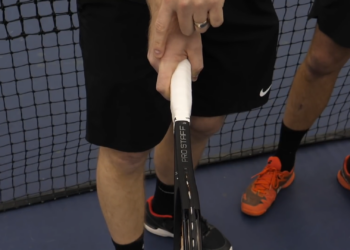Ever feel like your backhand is the unreliable roommate in your tennis game, the one that bails when things get tough?
As a coach and a lifelong tennis junkie, I’ve worked with thousands of players who’ve wrestled with the same backhand frustrations: shots that flutter into the net, wild swings that sail long, or that deflating feeling when you know your opponent is targeting your weaker side… and you can’t do much about it.
Here’s the deal: the backhand is tricky because it doesn’t feel as natural as the forehand.
Whether you’re learning a two-hander or a one-hander, you’re working against your body’s instincts at first. Beginners struggle with:
- Inconsistency—One day it’s clean, the next day it’s chaos.
- Weak shots—That frustrating “pushed” ball that just sits up begging to be punished.
- Fear of mishits—Especially in pressure moments like tiebreakers.
Deep breath. I built PlayYourCourt, and this guide, to solve exactly these kinds of struggles.
We’re here to help you build a clean, consistent, and safe backhand that holds up in real matches. And once you’ve got that solid foundation? Then we’ll unlock the power and spin that makes your backhand a true weapon.
Let’s dive in and get your backhand working for you, not against you.
Step 1 – Get Into the Right Ready Position
What Is the Ready Position for a Backhand?
Before you even think about swinging, your backhand starts with how you stand.
This part gets overlooked all the time by beginners. Think of your ready position as the launch pad. Get it right, and you’re set up for success.
Get lazy with it? You’re already playing catch-up.
Here’s your baseline:
- Feet shoulder-width apart.
- Knees bent and springy.
- Weight on the balls of your feet (not your heels).
- Racquet up and out in front of you, ready to pivot.
I like to explain it this way: picture a boxer in the ring. They’re light, alert, and always ready to move in any direction.
That’s exactly how you need to feel at the baseline, primed to explode to either your forehand or your backhand side without hesitation.
Why does this matter? Because tennis is a game of split-seconds.
If you’re slow getting into position, even the best swing technique in the world won’t save you. The right ready position creates time and that’s pure gold when you’re under pressure.
Mistakes to Avoid
- Standing Too Upright:If your knees aren’t bent and your stance is stiff, you’re killing your reaction time before the ball’s even crossed the net.
- Being Flat-Footed: Weight stuck on your heels? That’s a one-way ticket to late backhands. Stay on the balls of your feet so you can push off instantly when you need to move.
The truth is, a lot of what feels like “bad backhand technique” is really just bad preparation.
Nail this step and you’ll be amazed how much cleaner and more confident your backhand feels, before you even change your swing.
Step 2 – Choose Your Backhand: One-Handed vs. Two-Handed
Which Backhand Is Best for You?
Ah, the age-old question: one-handed or two-handed backhand?
I get asked this all the time, and here’s the talk – you can’t just copy your favorite pro and expect it to work out (looking at you, Federer fans 😅).
Your ideal backhand is going to depend on your body, your goals, and your playing style.
Let’s break it down:
One-Handed Backhand: Pros & Cons
✅ Pros:
- Reach: Great for stretching wide balls.
- Slice & Finesse: This is your tool for silky slices and variety – drop shots, angles, you name it.
- Style Points: Let’s be real – it looks amazing when done well.
🚫 Cons:
- Harder to Master: Timing and technique have to be spot on.
- Less Stable: Can struggle against heavy topspin or high-bouncing balls, especially on clay.
- More Strain: Greater risk of wrist or elbow issues if mechanics aren’t dialed in.
✋ Two-Handed Backhand: Pros & Cons
✅ Pros:
- Power & Stability: More muscle groups involved = easier to generate solid, controlled power.
- Consistency: Much easier for beginners to learn and build confidence.
- Handling High Balls: Better equipped to handle shoulder-height shots.
🚫 Cons:
- Less Reach: Harder to stretch out wide.
- Less Slice Variety: Slicing is trickier (though not impossible) with a two-hander.
🛠️ Quick Diagnostic: What Fits You Best?
- Are you younger or just starting out? Two-hander all the way.
- Do you have excellent timing and flexibility? You might consider a one-hander.
- Looking for maximum power and easier progress? Stick with two hands.
- Want variety and already have a solid base? A one-hander could be a fun challenge later.
👉 My Rule of Thumb: Unless you have a coach pushing you toward a one-hander early on (and a really good reason), I strongly recommend starting with the two-handed backhand.
It’s faster to learn, more forgiving, and honestly, the game has evolved toward two-handers for a reason.
❗ Big Question: Can You Switch from Two-Handed to One-Handed Later?
Short answer: Yes, but tread carefully.
I’ve worked with players who’ve successfully made the switch, but here’s the catch: it’s a process.
Most beginners jump ship too soon, thinking a one-hander will magically “fix” their struggles. Spoiler: It won’t if the fundamentals aren’t solid.
✅ If you do want to transition later:
- Make sure your footwork, timing, and core strength are rock solid first.
- Work with a coach (seriously, this is one time when winging it won’t cut it).
- Start slowly, blending in slices and progressions before going full one-hander in matches.
The bottom line? Don’t overthink it right now. Our mission is to get you a strong, safe, and consistent backhand ASAP and for 95% of players, that starts with the two-hander.
Step 3 – Master the Grip (for Both Styles)
Let’s get one thing straight: your grip is the foundation of your backhand.
I know, it sounds basic, but if your grip’s off, everything else is going to feel awkward, inconsistent, and, frankly, frustrating.
Two-Handed Backhand Grip (For Beginners)
If you’re rocking the two-hander (which, as we covered, is where most beginners should start), here’s your go-to setup:
- Bottom Hand: Use an Eastern forehand grip – imagine shaking hands with your racquet. Your palm should sit comfortably on the side bevel of the handle.
- Top Hand: This is your driver. Place your non-dominant hand above the bottom one, with your knuckles flush behind the grip. Think of it like holding a hammer – you want to feel control, but stay relaxed.
Pro Tip: Your top hand does most of the work in a two-handed backhand.
That might sound weird at first, but trust me: your non-dominant hand is what pulls the racquet through the swing and generates the magic, power, spin, and direction.
Your bottom hand? It’s just along for the ride, helping with balance and guidance.
One-Handed Backhand Grip
For the one-handers out there, we keep it classic:
- Continental Grip: Yep, this is the “universal” grip that looks like you’re holding a hammer or shaking hands with your racquet. Place the pad of your index finger along bevel #1 (the top bevel if your racquet is perpendicular to the ground).
Easy Visualization: Put your racquet on the ground, pick it up naturally like you’re shaking hands with it – that’s your continental grip right there.
This grip is super versatile and sets you up to hit clean slices and topspin backhands with the same basic foundation.
Step 4 – Backhand Swing Path Breakdown (The 4 Key Stages)
Alright, here’s where it all starts coming together. You’ve got your stance. You’ve got your grip. Now it’s time to actually hit the ball and hit it clean.
Whether you’re using one hand or two, every good backhand follows the same four main stages.
Let’s break it down so it’s easy to remember and even easier to execute.
Turn & Coil
This is your wind-up. Before you swing, you’ve got to load up energy and that comes from turning your whole body, not just your arms.
- Cue: Imagine your shoulder tucking under your chin as you turn. That’s your sign you’re coiling properly.
- Rotate your hips and shoulders together. This is what stores power and sets you up for a fluid swing.
Big mistake to avoid: Most beginners get so eager to hit the ball that they lead with their arms alone. That’s a recipe for weak shots and mishits.
Think of your swing as a team effort – legs, core, shoulders, and arms all working together.
The Swing: Dip and Lift
Here’s where the magic happens. The secret to a controlled, spin-friendly backhand? A swing path that starts low and finishes high.
- Visual Cue: Imagine you’re holding your racquet over a pool. Now dip it down and splash your friend next to you. That low-to-high motion is exactly what you want.
- Keep your swing smooth and relaxed, no chopping or stabbing at the ball.
This swing path helps you generate topspin, lift, and safety over the net – key ingredients for a backhand that doesn’t break down under pressure.
Contact Point
This is your make-or-break moment.
- You want to meet the ball slightly in front of your body, not jammed in close, and not way out ahead.
- Eyes locked in through contact. One of the biggest mistakes? Players peek early to see where the ball’s going, and that kills clean contact.
Pro tip: If your backhand keeps going long or feels late, check your contact point first. Nine times out of ten, that’s the culprit.
Follow Through
Your follow-through is your finish line, and it tells you if everything before it was done right.
- Two-Handed Backhand: “Answer the phone.” Your racquet should finish up near your opposite shoulder, like you’re holding a phone to your ear.
- One-Handed Backhand: Aim for a high, flowing finish over your shoulder. Keep your body balanced and controlled – no flopping backward or over-rotating.
The follow-through isn’t just for show; it’s what locks in your swing path and keeps your shot clean, controlled, and ready for the next ball.
Master these four stages and you’re going to feel stronger, smoother, and more confident every time you step up to hit a backhand.

Step 5 – Build Consistency First (Before Power)
Let’s focus on building a backhand you can trust, every single time.
Why You Keep Mishitting Your Backhand
If your backhand feels unpredictable, chances are one (or more) of these culprits is sabotaging your swing:
The “Death Grip” Problem
You’re squeezing your racquet like it’s a lifeline. I get it, you’re nervous, you want control. But ironically, the tighter you grip, the less control you have. A tight grip chokes off fluidity and kills racquet head speed.
Misjudging the Contact Point
Hitting too close to your body? You’ll jam yourself and spray the ball. Too far out? You’ll lose stability.
The sweet spot is slightly ahead of your body, with your eyes locked on the ball.
Lack of Follow-Through
Beginners often stop their swing after contact, like they’re afraid of what might happen next.
But your swing needs to flow all the way through – that’s what lifts the ball over the net and keeps it deep.
Fixes
Relax the Grip (3/10 Pressure)
Think of your grip pressure like a dial from 1 to 10. You want to live around a 3 out of 10.
Secure enough to control the racquet, but loose enough that someone could pull it out of your hand without a wrestling match. This keeps your swing smooth and natural.
Shadow Swings + Slow Motion Drills:
This is pure gold for building consistency. Practice your full backhand swing without a ball, focusing on the swing path, contact point, and follow-through.
Go slow and feel every part of the motion.
Bonus: use a mirror or record yourself to spot breakdowns.
I can’t stress this enough: consistency is your foundation. Once you have that, power and spin will layer on naturally. But rush it? You’re setting yourself up for frustration.
Step 6 – How to Add Power (The Safe Way)
Everyone wants a backhand that packs a punch.
But here’s what I tell every player: if you try to force power with just your arms, you’re not only going to hit weak shots, you’re also setting yourself up for injuries (tennis elbow 👎).
The key? Use your whole body.
Use Your Body, Not Just Your Arms
Great backhand power starts from the ground up. Your racquet is just the final piece of the puzzle – it’s your legs, hips, and core that actually generate the force.
- Coil: As you turn to set up your backhand (remember that shoulder-under-your-chin cue), you’re storing energy in your legs and torso.
- Uncoil: When you swing, you release that stored energy by driving your hips and shoulders forward through the shot.
Why this matters: Most beginners think, “Swing faster, hit harder.”
But here’s the secret: your back foot is your power source. Push off that back leg as you uncoil, and you’ll be amazed how much easier it is to drive the ball deep, with less effort and more control.
Power Drill Ideas
Want to train your body for effortless power? Here are two of my go-to drills:
Resistance Bands for Strength:
- Anchor a resistance band around a fence or pole.
- Mimic your backhand swing path against the band’s tension.
- Focus on smooth, core-driven movement, feel your hips and torso do the work, not just your arms.
Shadow Swing + Live Ball Sequence:
- Do 5-10 slow, exaggerated shadow swings, focusing on full body rotation.
- Follow immediately with 5 live ball hits, keeping that same full-body feel.
- This helps bridge the gap between practice and real-play muscle memory.
One of my favorite things to see is a student who finally “gets” that feeling when your swing feels smooth but the ball just explodes off your strings.
That’s when you know your body is working as a unit.
FAQ: Backhand Questions You Might Be Asking
You’re working hard on your backhand, but questions pop up all the time when you’re out on the court.
Here are some of the top things I get asked (and exactly how to handle them).
How Do I Handle High-Bouncing Backhands?
Ah, the classic nightmare, especially if you’re playing on clay or facing a topspin-heavy opponent.
The trick? Adjust early.
- Get your feet moving fast and try to take the ball early before it jumps too high.
- If it’s already climbing out of your strike zone, open your stance slightly and hit with a higher contact point, keeping your racquet face stable.
- And don’t be afraid to throw in a slice, it’s a great neutralizer when you’re out of position.
💭 How Can I Switch from Slice to Topspin Mid-Rally?
This is where having good fundamentals really pays off. The key is early preparation.
- As soon as you recognize the incoming ball, decide: slice or topspin?
- For slice, keep your racquet face slightly open and your swing more downward and linear.
- For topspin, adjust to a low-to-high swing path and close your racquet face just a touch.
The real secret? Practice both in drills so your muscle memory knows exactly what to do without hesitation.
💭 Can I Use Off-Court Tools to Improve My Backhand?
Absolutely and you should! Two of my favorites:
- Resistance Bands: Perfect for strengthening the exact muscles you use in your swing.
- Shadow Swings in Front of a Mirror: Groove that swing path and work on timing without needing court time.
Even 10 minutes a day can make a massive difference in your feel and strength over time.
💭 Why Does My Backhand Go Long Even When It Feels Right?
Such a popular (and frustrating) issue. Usually, it comes down to one of two things:
- Your racquet face is too open at contact, double-check that your strings are slightly closed as you swing through.
- You’re peeking early, lifting your head to see where the ball’s going. Stay disciplined and keep your eyes locked on contact until your follow-through is complete.
Got a specific question that’s bugging you? PlayYourCourt coaches are here to troubleshoot your backhand one-on-one, with drills and video analysis tailored to exactly what you need. 💡
Top Beginner Mistakes (And How to Fix Them Fast)
Nobody’s perfect when they’re learning, but these are the biggest mistakes I see all the time with backhands.
The good news? Every single one is easy to fix once you know what to look for.
Swinging Too Hard Too Early
The problem: You’re chasing power before you’ve built consistency. The result? Mishits, wild balls, and a whole lot of frustration.
The fix: Dial it back. Focus on smooth, controlled swings. Power comes naturally when your timing and technique are locked in. Trust the process.
🚫 Flipping the Wrist Mid-Swing
The problem: Trying to “add extra” at contact by snapping your wrist – this kills control and often sends balls flying or into the net.
The fix: Keep your wrist firm and stable through contact. Think of your racquet head like a hammer – you’re driving through, not flicking at the last second.
Not Recovering After the Shot
The problem: You admire your shot (hey, we’ve all been there) or just stand frozen after hitting. Meanwhile, your opponent’s sending the next ball back.
The fix: Build the habit of immediate recovery. As soon as you finish your follow-through, reset your stance and get ready for the next move. Always stay in the rally mentally and physically.
Your Next Step: Improve Faster with PlayYourCourt

You’ve just learned the key steps to build a backhand that’s not only reliable but poised to become a true weapon.
But let’s face it, mastering tennis takes more than a great blog post. It takes consistent feedback, smart practice, and real-world application.
That’s exactly why we reimagined the PlayYourCourt membership. Our all-new membership is your complete tennis improvement hub.
We’ve built a platform that delivers everything you need to improve – faster, smarter, and more sustainably.
Ready to take the next step and make real, lasting progress?
Explore our membership and start transforming your backhand, and your entire game, today. 💪🎾



